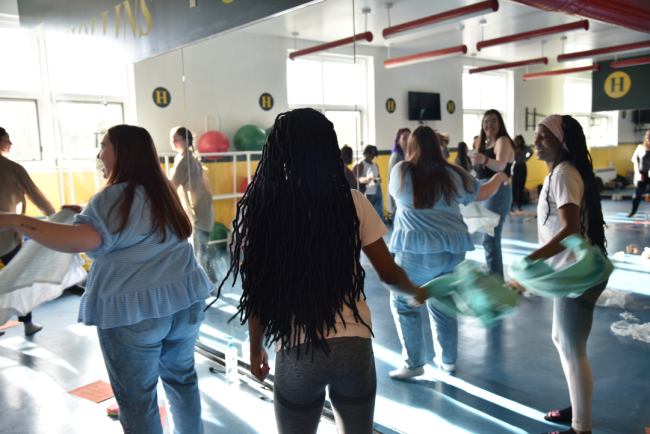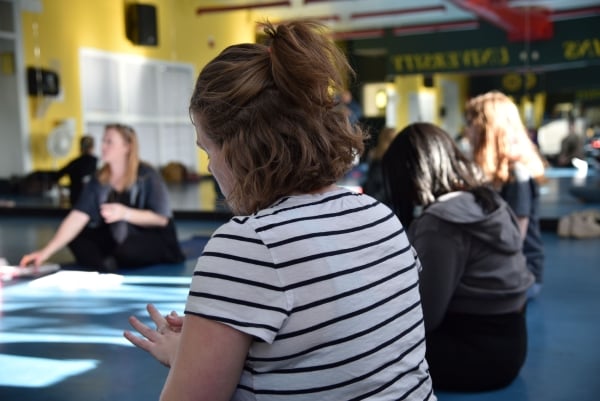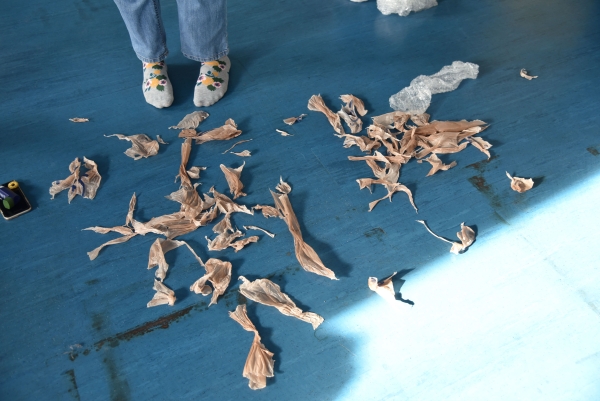You have /5 articles left.
Sign up for a free account or log in.

During one class period, Hollins students engaged in emotional resiliency, snapping dish towels repeatedly as a way to discharge their stress.
Abrina Schnurman/Hollins University
A January term can be an effective time block to allow students to squeeze in an extra class or participate in a micro-internship, work or study abroad. One professor at Hollins University in Virginia created a J-term course on resiliency and courage to support learners affected by the COVID-19 pandemic and subsequent lockdowns and isolation.
“Increasingly, undergraduate students are heading to campus with fewer coping skills to meet the intrapersonal and interpersonal challenges of this life stage,” says Abrina Schnurman, assistant professor and executive director of the Batten Leadership Institute at Hollins.
Many young students completed high school in isolation due to the pandemic and related stay-at-home orders, which can create social anxiety or a hesitancy to be involved in campus life, Schnurman adds. This inspired her to create the course, On Courage and Resiliency, for first-year students.
The three-week period covered healthy coping mechanisms, connecting with nature and establishing personal healing strategies.
How it works: The group met three days per week for three hours each day, with content focused on learning and enrichment in relation to healing and coping, Schnurman says.
Guests throughout the month provided additional perspectives and techniques. Lindsay McKinnon, a community-based loss and trauma integration specialist, led the class for three sessions, teaching Qoya yoga and trauma body reintegration. Jon Guy Owens, director of the Hollins Outdoor Program, taught students about forest bathing and nature walks, and Katherine Fralin Walker, director of the Batten Leadership Institute, led meditation as a self-leadership practice, Schnurman says.
Students also completed individual and group presentations, singling out one healing mechanism and sharing it with the class. Subjects ranged from outdoor activities and listening to music, rest, spiritual rituals and cooking.
Of the 27 course participants, two-thirds were first years and the rest a mix of sophomores, juniors and seniors.
Hollins’s theme for the January 2024 term is navigating and understanding conflict, so Schnurman’s course will be modified to focus on this area.
Digging deeper: Students walked away feeling more in control of their fears, better able to process emotions and more connected with their peers, according to end-of-term feedback.

Lindsay McKinnon, a trauma integration specialist and life coach, leads students in guided meditation.
Hollins University
One key assignment for the course was a 10- to 15-minute individual presentation on courage or resiliency activities. Students were asked to share a soothing technique they use on difficult days, identifying the research behind the activity and their personal experiences.
The assignment didn’t require vulnerability from the students, but “with a room full of relative strangers … they went deep,” Schnurman says.
Students revealed deeper traumas and healing from those hurts in a way that shocked Schnurman and made her realize how much her students dealt with every day and how well they did it.

One of the techniques students learned in their resiliency J-term seminar was shredding grocery bags to relieve stress.
Hollins University
“In most instances, and on most days, the vast majority beautifully contend with their struggles,” she shares. “I cannot help but wonder how validating the present and upholding where they are already resilient can surprise others as it did in our class, that they are already stronger than they ever considered.”
DIY: For an instructor looking to model her course, Schnurman offers three suggestions.
- Find strength in numbers. Working in group settings provided opportunities for cross-class engagement, encouragement and mentorship. The presentations also allowed students to be creative and dynamic, as well as showcase a wide variety of healing and coping activities.
- Connect with community. Internal and external partnerships from the institution can facilitate experiential elements into the course as well as expert perspectives. “Students took copious notes, asked questions and engaged with each of the three speakers,” Schnurman says.
- Separate grades from experiences. Schnurman made experiential elements ungraded to encourage curiosity and experimentation instead of performative work.
Do you have a wellness tip that might help others encourage student success? Tell us about it.




